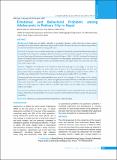Please use this identifier to cite or link to this item:
https://hdl.handle.net/20.500.14356/1483Full metadata record
| DC Field | Value | Language |
|---|---|---|
| dc.contributor.author | Sharma, Bharati | - |
| dc.contributor.author | Rai, Mana Kumari | - |
| dc.contributor.author | Sharma, Anju | - |
| dc.contributor.author | Karki, Sabita | - |
| dc.date.accessioned | 2023-05-14T08:21:36Z | - |
| dc.date.available | 2023-05-14T08:21:36Z | - |
| dc.date.issued | 2018 | - |
| dc.identifier.citation | SharmaB., RaiM. K., SharmaA., & KarkiS. (2019). Emotional and Behavioral Problems among Adolescents in Pokhara City in Nepal. Journal of Nepal Health Research Council, 16(41), 419-424. https://doi.org/10.33314/jnhrc.v16i41.1607 | en_US |
| dc.identifier.issn | Print ISSN: 1727-5482; Online ISSN: 1999-6217 | - |
| dc.identifier.uri | http://103.69.126.140:8080/handle/20.500.14356/1483 | - |
| dc.description | Original Article | en_US |
| dc.description.abstract | Abstract Background: Adolescents are highly vulnerable to psychiatric disorders, which often have serious negative consequences for their academic achievement and potential social life. The aim of the study is to estimate the prevalence of emotional and behavioral problems among adolescents. Methods: A descriptive cross-sectional study design was adopted to identify the emotional and behavioral problems among adolescents using cluster sampling technique. Assessment was done on students of grade 7-11 from two schools in city in Nepal using self-administered questionnaire, Youth Self-Report (YSR-11/18) 2001, developed by Achenbach System of Empirical Based Assessment and self developed socio-demographic questionnaires. Data was coded and analyzed using SPSS (20). Descriptive statistic and inferential statistic (Chi square, Fisher Exact and Odds ratio-OR) were used to analyze data. Results: Altogether 330 adolescents were enrolled in study with mean age 14.3 yrs (range 11-18, male-152, female-178). Prevalence of EBPs was 30.0% (Male-38.8% female-22.5%). Internalizing problems (35.8%) were more common than externalizing (18.5%). Occurrence of EBPs was significantly associated with Sex (OR= 2.2 p=0.001), type of family (OR=1.8 p=0.035) and types of school (private: public OR=2.1 p=0.004). Among narrow band scales most common problems were social (17.6%), thought (15.5%), somatic (13%), anxious depression (12.1%) and aggression(10.3%). There was significant association between sex with EBPs on narrow band scales, male adolescents were more likely to have thought-problem (OR=3.7 p=<0.001, rule-breaking problem (OR=8.5, p=0.02), aggressive behavior (OR=3.7 p=0.001) while female were more likely to have social problems (OR=2.6 p=0.002). Conclusions: Emotional and behavioural are a serious mental health concern among adolescents. An intervention strategy (School-based mental health service) maybe required to understand their problems and provide appropriate counseling. Keywords: Adolescents; emotional and behavioral problems; youth self report. | en_US |
| dc.language.iso | en | en_US |
| dc.publisher | Nepal Health Research Council | en_US |
| dc.relation.ispartofseries | Oct-Dec 2018;1607 | - |
| dc.subject | Adolescents | en_US |
| dc.subject | Emotional and behavioral problems | en_US |
| dc.subject | youth self report | en_US |
| dc.title | Emotional and Behavioral Problems among Adolescents in Pokhara City in Nepal | en_US |
| dc.type | Journal Article | en_US |
| local.journal.category | Original Article | - |
| Appears in Collections: | Vol. 16 No. 4 Issue 41 Oct - Dec 2018 | |
Files in This Item:
| File | Description | Size | Format | |
|---|---|---|---|---|
| 1607-Manuscript-7836-3-10-20190221.pdf | Fulltext Article. | 194.28 kB | Adobe PDF |  View/Open |
Items in DSpace are protected by copyright, with all rights reserved, unless otherwise indicated.
